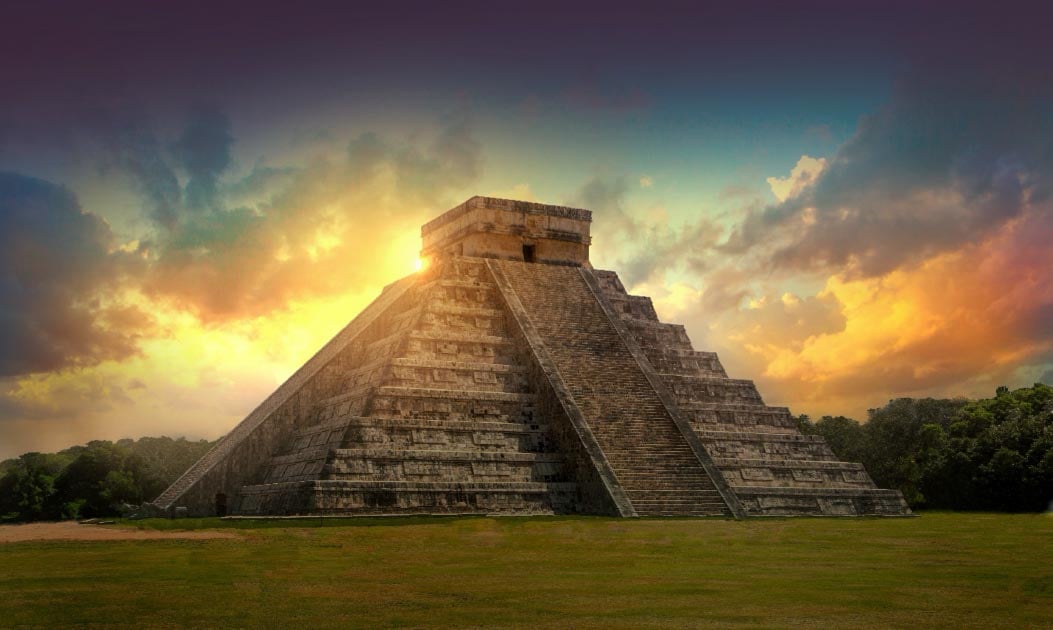3.Chichen Itza (Yucatan Peninsula, Mexico)
Chichén Itza, ruined ancient Maya city occupying an area of 4 square miles (10 square km) in south-central Yucatán state, Mexico. It is located some 90 miles (150 km) east-northeast of Uxmal and 75 miles (120 km) east-southeast of the modern city of Mérida. The only source of water in the arid region around the site is from wells (cenotes) formed by sinkholes in limestone formations. Two big cenotes on the site made it a suitable place for the city and gave it its name, from chi (“mouths”), chen (“wells”), and Itzá, the name of the Maya tribe that settled there. Chichén Itzá was designated a UNESCO World Heritage site in 1988.

Chichen Itza In Hindi, चिचेन इट्ज़ा कैनकन के पश्चिम में 200 किलोमीटर की दूरी पर युकाटन राज्य में स्थित है और यह मेक्सिको के सबसे संरक्षित पुरातात्विक स्थलों में से एक है। इट्ज़ा जातीय-वंश समुदाय का नाम है जिसने स्पेनिश विजय से पहले मैक्सिको के उत्तरी प्रायद्वीप पर शासन किया था। चिचेन इट्ज़ा नाम का मतलब होता है कुएं के किनारे। हर साल लगभग 1.2 मिलियन लोग चिचेन इट्ज़ा पर्यटन स्थल की यात्रा करते हैं। चिचेन इट्ज़ा का नाम दुनिया के 7 अजूबों की लिस्ट में आता है।
Chichen was founded about the 6th century CE, presumably by Maya peoples of the Yucatán Peninsula who had occupied the region since the Pre-Classic, or Formative, Period (1500 BCE–300 CE). The principal early buildings are in an architectural style known as Puuc, which shows a number of divergences from the styles of the southern lowlands. These earliest structures are to the south of the Main Plaza and include the Akabtzib (“House of the Dark Writing”), the Chichanchob (“Red House”), the Iglesia (“Church”), the Casa de las Monjas (“Nunnery”), and the observatory El Caracol (“The Snail”). There is evidence that, in the 10th century, after the collapse of the Maya cities of the southern lowlands, Chichén was invaded by foreigners, probably Maya speakers who had been strongly influenced by—and perhaps were under the direction of—the Toltec of central Mexico. These invaders may have been the Itzá for whom the site is named; some authorities, however, believe the Itzá arrived 200 to 300 years later.
In any event, the invaders were responsible for the construction of such major buildings as El Castillo (“The Castle”), a pyramid that rises 79 feet (24 metres) above the Main Plaza. El Castillo has four sides, each with 91 stairs and facing a cardinal direction; including the step on the top platform, these combine for a total of 365 steps—the number of days in the solar year. During the spring and autumnal equinoxes, shadows cast by the setting sun give the appearance of a snake undulating down the stairways. A carving of a plumed serpent at the top of the pyramid is symbolic of Quetzalcóatl (known to the Maya as Kukulcán), one of the major deities of the ancient Mesoamerican pantheon. Excavations within the nine-platform pyramid revealed another, earlier structure containing a red jaguar throne studded with jade.
About 1450 the League and the political supremacy of Mayapán dissolved. When the Spanish entered the country in the 16th century, the Maya were living in many small towns, but the major cities, including Chichén, were largely abandoned.
GENERAL ABOUT
FACT ABOUT Chichen Itza😲
1. Chichen Itza is classified as one of the New Seven Wonders of the World and in 1988 was enlisted as an UNESCO World Heritage Site.
2. The term Chichen Itza means ‘the mouth at the well of Itza’. It is believed Itza means ‘water magicians’, deriving from the Mayan Itz for ‘magic’ and á for ‘water’.
3. El Castillo (the Temple of Kukulkan) is the famous pyramid which dominates the site of Chichen Itza and it actually sits on another much older temple.
4. Believed by archaeologists to have been a powerful economic city around 600 AD, the fall of Chichen Itza is thought to have been approximately 1000 AD.
5. The design and layout of Chichen Itza was clearly well planned and builders constructed temples and pyramids in sets of clusters.
Comments
Post a Comment